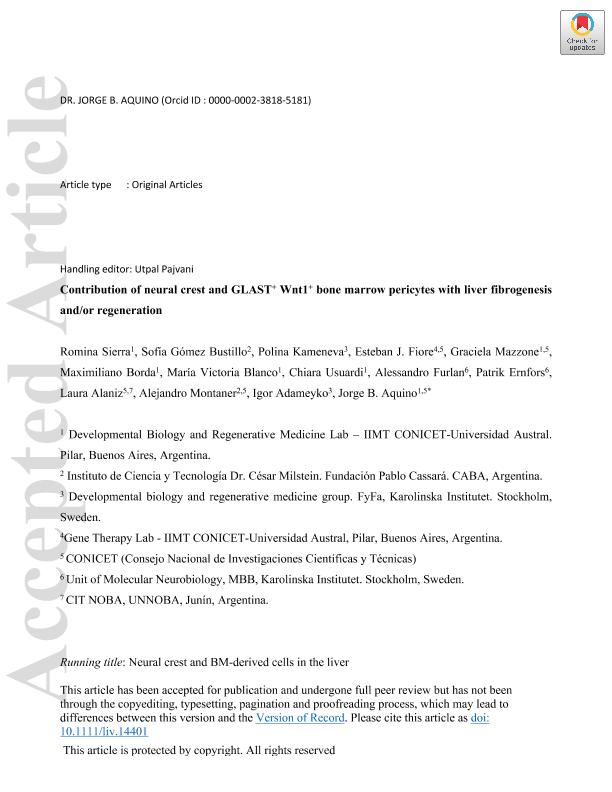Artículo
Contribution of neural crest and GLAST+ Wnt1+ bone marrow pericytes with liver fibrogenesis and/or regeneration
Sierra, Romina ; Gomez Bustillo, Sofia
; Gomez Bustillo, Sofia ; Kameneva, Polina; Fiore, Esteban Juan
; Kameneva, Polina; Fiore, Esteban Juan ; Mazzone, Graciela Luján
; Mazzone, Graciela Luján ; Borda Acevedo, Franco Maximiliano
; Borda Acevedo, Franco Maximiliano ; Blanco, María V; Usuardi, Chiara; Furlan, Alessandro; Ernfors, Patrik; Alaniz, Laura Daniela
; Blanco, María V; Usuardi, Chiara; Furlan, Alessandro; Ernfors, Patrik; Alaniz, Laura Daniela ; Montaner, Alejandro Daniel
; Montaner, Alejandro Daniel ; Adameyko, Igor; Aquino, Jorge Benjamin
; Adameyko, Igor; Aquino, Jorge Benjamin
 ; Gomez Bustillo, Sofia
; Gomez Bustillo, Sofia ; Kameneva, Polina; Fiore, Esteban Juan
; Kameneva, Polina; Fiore, Esteban Juan ; Mazzone, Graciela Luján
; Mazzone, Graciela Luján ; Borda Acevedo, Franco Maximiliano
; Borda Acevedo, Franco Maximiliano ; Blanco, María V; Usuardi, Chiara; Furlan, Alessandro; Ernfors, Patrik; Alaniz, Laura Daniela
; Blanco, María V; Usuardi, Chiara; Furlan, Alessandro; Ernfors, Patrik; Alaniz, Laura Daniela ; Montaner, Alejandro Daniel
; Montaner, Alejandro Daniel ; Adameyko, Igor; Aquino, Jorge Benjamin
; Adameyko, Igor; Aquino, Jorge Benjamin
Fecha de publicación:
02/2020
Editorial:
Wiley Blackwell Publishing, Inc
Revista:
Liver International
ISSN:
1478-3223
Idioma:
Inglés
Tipo de recurso:
Artículo publicado
Clasificación temática:
Resumen
Background and aims: Liver fibrosis results from cycles of liver damage and scar formation. We herein aimed at analysing neural crest cells and/or bone marrow stromal cells contribution to the liver. Methods: Two liver fibrosis and one hepatectomy model were applied on double-transgenic loxP-Cre mouse lines. Results: Increased numbers of glia with more complex processes were found in fibrotic livers. During embryonic development, only few cells were traced in the liver and bone marrow, in a minor fraction of mice of different neural crest reporter strains analysed: therefore, a neural crest origin of such cells is doubtful. In the fibrotic liver, a significantly higher incidence of endothelial cells and hepatocyte-like cells expressing the reporter gene Tomato were found in Wnt1-Cre-Tom and GLAST-CreERT2-Tom mice. Consistently, during early fibrogenesis stromal Wnt1-traced cells, with progenitor (CFU-F) properties, get likely mobilized to peripheral blood. Circulating adult Wnt1-traced cells are stromal cells and lack from the expression of other bone marrow and endothelial progenitor cells markers. Furthermore, in a 70% hepatectomy model GLAST+ Wnt1-traced pericytes were found to be mobilized from the bone marrow and the incidence of GLAST-traced hepatocyte-like cells was increased. Finally, GLAST-traced hepatocyte like-cells were found to maintain the expression of stromal markers. Conclusions: Our data suggest a gliosis process during liver fibrogenesis. While neural crest cells probably do not contribute with other liver cell types than glia, GLAST+ Wnt1-traced bone marrow pericytes are likely a source of endothelial and hepatocyte-like cells after liver injury and do not contribute to scarring.
Archivos asociados
Licencia
Identificadores
Colecciones
Articulos(ICT - MILSTEIN)
Articulos de INST.DE CS. Y TECNOLOGIA "DR. CESAR MILSTEIN"
Articulos de INST.DE CS. Y TECNOLOGIA "DR. CESAR MILSTEIN"
Articulos(IIMT)
Articulos de INSTITUTO DE INVESTIGACIONES EN MEDICINA TRASLACIONAL
Articulos de INSTITUTO DE INVESTIGACIONES EN MEDICINA TRASLACIONAL
Citación
Sierra, Romina; Gomez Bustillo, Sofia; Kameneva, Polina; Fiore, Esteban Juan; Mazzone, Graciela Luján; et al.; Contribution of neural crest and GLAST+ Wnt1+ bone marrow pericytes with liver fibrogenesis and/or regeneration; Wiley Blackwell Publishing, Inc; Liver International; 40; 4; 2-2020; 977-987
Compartir
Altmétricas



